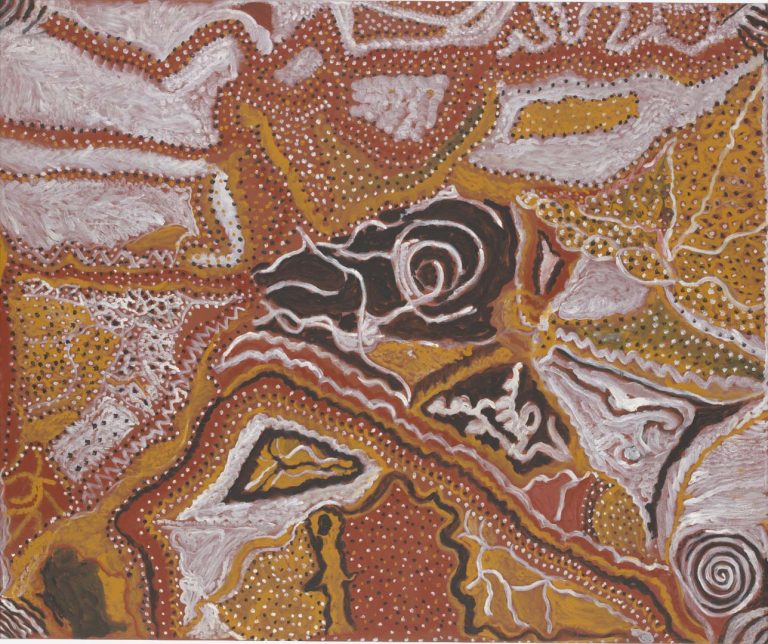We acknowledge the Traditional Owners of the land on which the Queensland Art Gallery | Gallery of Modern Art stands and recognise the creative contribution First Australians make to the art and culture of this country.

Mavis Ngallametta / Kugu-Uwanh people, Putch clan / Australia 1944–2019 / Untitled 2010 / Natural pigments with synthetic binders on linen / 116 x 111cm / Gift of the artist through the Queensland Art Gallery | Gallery of Modern Art Foundation 2015. Donated through the Australian Government’s Cultural Gifts Program / Collection: Queensland Art Gallery | Gallery of Modern Art / © The Estate of Mavis Ngallametta
Mavis NGALLAMETTAUntitled 2010
Not Currently on Display
We always go out and collect the ochre from the salt pan. We always prepare the area first where we see it, where it’s a little bit salt, like you can see it white and a little bit red on the top part of the ground. When we dig it, we have to look for that special yellow, then we bring it back to the art centre and lay it out to get dry. Then we use a sifter to take the lumps out, then mix that soft part with water. After that, we make a fire so it can be cooked from yellow to red.1
As a teenager, Mavis Ngallametta learnt how to harvest and prepare ochre and pigments from her elders Uncle James and Aunty Annie Kalkeeyorta. Natural pigments — ochre, clay and charcoal from her country — were central to the artist’s practice. These pigments gave her paintings an alluring tactility that helps draw viewers closer to investigate the paint itself.
Ngallametta’s works were extremely labour intensive to create; in the studio, other women who painted with acrylics would finish a work before Mavis had even collected her raw materials, let alone processed them or had begun to paint herself. She deliberately and painstakingly constructed her paintings to ensure that culturally, spiritually and physically the works contained the essence of the places they depicted.
Endnotes:
1. Mavis Ngallametta, quoted in Sally Butler (ed.), Before Time Today: Reinventing Tradition in Aurukun Aboriginal Art [exhibition catalogue], University of Queensland Press, St Lucia, Qld, 2010, p.92-4.
Mavis Ngallametta was born in 1944 into the Marbunt family of the Kugu people on their traditional country, near the Kendall River in west Cape York Peninsula. An elder of the Putch clan and a cultural leader of the Wik and Kugu people of Aurukun, Mavis is remembered for her rich legacy to her community and to art and culture nationally. Mavis embarked on her journey to become a painter relatively late in life — she did not pick up a paintbrush until 2008, at the age of 64.
Mavis lived a traditional life in the bush until she was around five, when her family was moved to the Presbyterian Mission at Aurukun. She maintained connections with family members and elders despite this upheaval, and, in time, learnt to weave dilly bags and fruit bowls made from cabbage palm and pandanus. As a result, she was first recognised for her weaving using traditional materials, which later expanded to include recycled driftnets and marine debris.
In 2008, Ngallametta began making small paintings depicting important cultural sites, and from 2010, her works grew in scale. Mavis tended to depict sites of personal significance in her paintings. Recurring subjects include Ikalath, where she collected white clay; her traditional country of Kendall River; Wutan, a camping site belonging to her adopted son Edgar; and various pamp, or swamps, dotted around Aurukun.
Discussion Questions
1. Look closely at this painting. Identify areas of the work that the artist has painted in natural pigments and those painted in acrylics. How can you tell the difference between the two mediums?
2. List the colours of the work from most prominent to least. Repeat this exercise with Pamp (Swamp) 2009 and Collecting Pip Morp (white clay) at Ikalath 2009. What do you think is significant about the dominant colours in these early works?
Classroom Activities
Experiment with making your own natural and plant-based pigments using materials such as charcoal, chalk, clay, blueberries, turmeric and instant coffee. Use different binders — natural (water, egg, wax) and synthetic. How do these pigments compare to acrylic and oil paints?